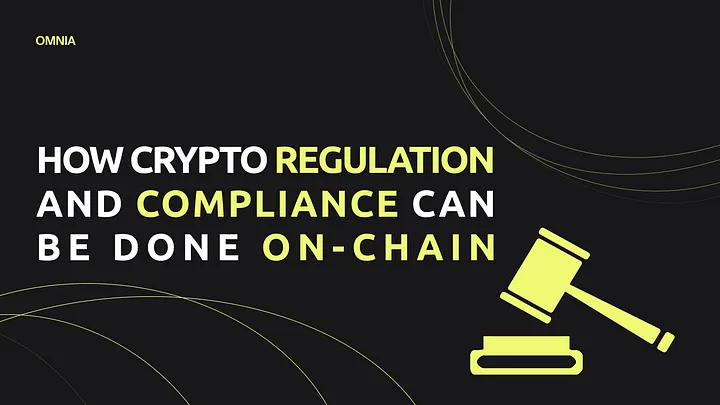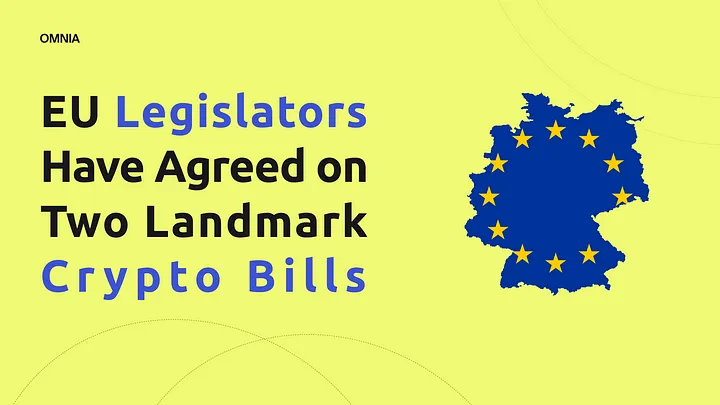
How Crypto Regulation and Compliance Can be Done On-chain.
The future of blockchain and crypto is intertwined with complying with existing financial regulations, global sanctions against individual states and individuals, and laws that protect retail traders from malpractices such as frontrunning, insider trading, invasion of privacy, and use of personal data for all the wrong reasons.
The EU has already passed the Crypto Assets (MiCA) bill and the Transfer of Funds Regulation (TFR) bill to start the process of ending the ‘Wild West of unregulated crypto.’
A significant requirement of the two bills is that Crypto Asset Providers, including crypto exchanges, monitor individual transactions to ensure they adhere to sanctions and existing AML and KYC requirements, such as reporting large transfers above $1,000. The same Crypto Asset Providers must adhere to strict data protection laws when collecting and processing transactional information.
At the same time, US legislators are drafting crypto regulation through ‘The Responsible Financial Innovation Act’ proposed by Senators Lummis and Gillibrand. The SEC and CFTC are also figuring out how existing laws can encompass the crypto industry.
Legacy Systems Are Not Built to Handle the Speed and Magnitude of Blockchain Data — Charles Hoskinson.
The urgency of regulation in the United States prompted the US House of Representatives to invite Ethereum Co-founder and Cardano Founder Charles Hoskinson to discuss blockchain and crypto in late June this year.
During his opening remarks, Mr. Hoskinson pointed out that the blockchain industry has grown exponentially in the last decade, presenting new challenges for legacy financial systems intending to regulate the industry.
According to Mr. Hoskinson, the legacy financial and regulatory systems cannot handle the rapid movement of value on the blockchain without centralized middlemen. He added, ‘the current regulatory tools, risk management systems, and oversight processes were never designed for such speed, scale, and rapid evolution.’
The Future of Crypto Compliance and Regulation is On-Chain.
In his informative address to US Congressmen and women, Mr. Hoskinson highlighted that cryptocurrencies and other digital assets, such as NFTs, were very transparent since blockchain transactions are immutable and public.
Consequently, he recommended that regulation and compliance of the industry required a partnership with blockchain developers who would design software tools to streamline the process.
He outlined that Chainalysis was already providing and developing on-chain analysis tools that the various regulatory agencies could implement.
Existing Projects Solving On-chain Compliance.
Charles Hoskinson’s comments were particularly insightful as most lawmakers, users of traditional financial and even crypto users and investors, were unaware of existing projects tackling compliance and regulation on the blockchain.
In addition to Chainalysis, several projects are working towards solving the problem of compliance and regulation by developing on-chain tools to automate and make the process more efficient. A sample of such blockchain projects, in addition to Chainalysis, can be found below.
- The Astra Protocol is working on a decentralized compliant layer for the Web3 economy that aims to solve compliance on the blockchain. Their work is centered around assisting the DeFi industry to become regulatory compliant, battle fraud, implement the travel rule at the core of the EU’s TFR bill, provide legal safeguards and insurance, and minimize money laundering through AML implementation processes on-chain.
- Securrency is also working on solving regulations and compliance not only in the US and EU but across different geographic jurisdictions by automating the process on-chain, thus allowing value to be transferred across borders in real-time while respecting all the rules and regulations along the way.
- EMURGO, Cardano’s financial arm, recently partnered with Blockpass to integrate on-chain KYC servers for Cardano ecosystem projects.
OMNIA’s Mission is to Be Compliant with Regulations and Sanctions.
The team at OMNIA is aware that the future of the crypto and blockchain industries is interlaced with complying with existing privacy and financial laws aimed at protecting retail and institutional investors. In addition, the Axie Infinity hack and Russia’s invasion of Ukraine brought to light another challenge of implementing sanctions against individuals and states on the blockchain.
Furthermore, the fine details of incoming crypto regulations, such as the MiCA and TFR bills, must be carefully studied and implemented on-chain as soon as both laws come into full effect in the next 18 to 24 months.
Consequently, the team at OMNIA is fully committed to addressing such concerns. Strict measures are being implemented at the privacy relayers dAPI gateways that act as entry points to blockchain networks to filter out transactions linked to illicit activities or part of any sanctioned list.
Users’ off-chain privacy is also assured since blockchain requests go through OMNIA’s mixnets; thus, the final node processing the transaction will not be able to access any metadata or behavioral information.

